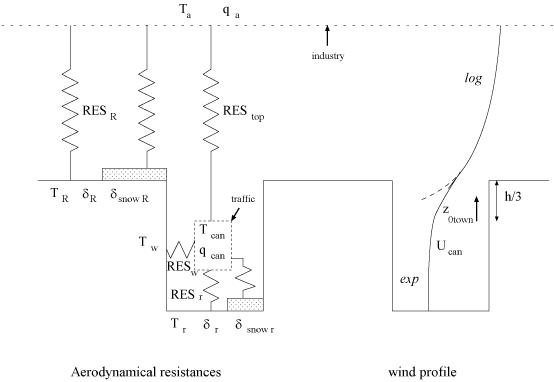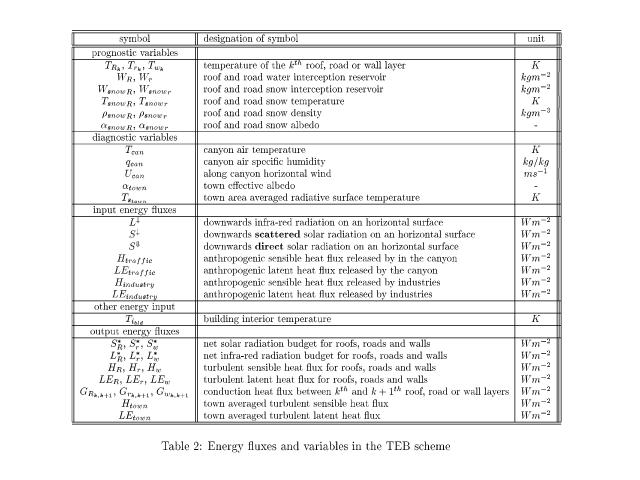
A complete physically-based Town Energy
Budget scheme for atmospheric models
An urban surface model for atmospheric meso-scale models is presented.
A generalization of local canyon geometry is
defined instead of the usual bare soil formulation currently used
to represent cities in atmospheric models. This allows refinement of
the radiative budgets as well as momentum, heat and conduction fluxes.
This scheme is aimed to be as general as possible, in order to represent
any city in the world, for any time or weather condition
(heat island cooling by night, urban wake, water evaporation after rainfall
and snow effects.
The Town Energy Budget (TEB) scheme is built following
the canyon approach, generalized in order to represent larger
horizontal scales.
The physics treated by the scheme are relatively complete.
Due to the complex shape of the city surface, not one but three
energy budgets are considered: one for the roofs, one
for the roads, and one for the walls. Orientation effects
are averaged for roads and walls. Up to two energy budgets are
added for snow when it is present on roofs or roads.
Some of the physics were derived from the literature (long wave radiation or
thermal conduction through the surfaces), since they are classically assumed
to estimate building temperature in conditions
without feedback towards atmosphere (during night with calm wind).
However, most parts of the physics need an original approach
(short wave radiation,
thermodynamical and anthropogenic flux treatment, rain and snow),
since they occur when interaction with the atmosphere is strong.
a.) Context
The Town Energy Budget model is aimed
to simulate the surface exchange turbulent fluxes with the atmosphere
at the surface of a meso-scale atmospheric model, when it is covered
by buildings, roads, or any artificial material.
It must be considered as a part of the surface parameterization set
of the atmospheric model. The fluxes should be computed for each surface type
by the appropriate scheme, and then averaged in the atmospheric model grid
mesh, in respect to the proportion occupied by each type.
For example, a partition should be:
(1) sea; (2) inland water; (3) natural and cultivated terrestrial surface;
(4) towns. The following fluxes will be calculated:
latent and sensible heat fluxes W m^-2, and momentum fluxes
along the axes of the model m^2 s^-2.
b.) Town geometry description
Numerous fine-scale studies on buildings climatology exist throughout
the world. In those, several individual buildings are usually
present, in order to study their radiative interaction,
the wind channeling effects, or the building isolation.
The canyon concept developped by city climatologists
(e.g. Oke 1987) takes place into such frames:
it considers a single road, bordered by facing buildings.
These studies are, at best, forced by atmospheric data (radiation, wind
above the roofs), but are not in interaction with it.
The TEB model is aimed to parameterize the town-atmosphere
dynamical and thermodynamical interactions. It works for meso-scale
atmospheric models (grid mesh larger than few hundreds of meters).
Then, spatial
averaging of the town characteristics as well as its effect on the atmosphere,
is necessary.
The individual shapes
of each building are no longer taken into account.
The TEB geometry is based on the canyon hypothesis. However, a
single canyon would be to restrictive at the
considered horizontal scale.
We therefore use the following
original city representation
1. the buildings have the same height and width (in the model mesh).
2. they are located along identical roads, the length of which is considered
far greater than their width. The air contained between two facing buildings
is then a canyon.
3. any road orientations is possible, and all of them exist
with the same probability. This hypothesis allows to compute averaged forcings
for road and wall surfaces. In other words, when the canyon orientation
appears in a formula (with respect to the sun or the wind directions),
it is averaged on 360 degrees. In this way, no discretization is performed
on orientation, leading to a relatively simple scheme.
c.) Physical phenomena handled by the Town Energy Budget scheme
The physics treated by the scheme are relatively complete.
Due to the complex shape of the city surface, not one but three
energy budgets are considered: one for the roofs, one
for the roads, and one for the walls. Orientations effects
are averaged for roads and walls. Up to two energy budgets are
added for snow when it is present on roofs or roads.
Some of the physics were found in the state of art (long wave radiation or
thermal conduction through the surfaces), since they are classically assumed
to estimate building temperature in conditions
whitout retro-action towards atmosphere (during night with calm wind).
Because the roof heights are supposed to be uniform, this also allows to
use some classical approch for the fluxes characteristics above
the roof level.
These physics (listed hereafter) are not original in themselves,
but so is their application to an averaged city geometry:
- trapping of long-wave radiation by the canyon surfaces, with one
re-emission taken into account [Johnson et al. (1991) formulation].
- The explicit conduction fluxes inside the buildings and road
allow to take into account the layer-type struture of these surfaces
(e.g. insulation layers) with the minimum of approximation.
- the effect of stability within the urban rouhgness boundary layer
and the boundary layer above it (by use of friction coefficients and
aerodynamical resistances).
- the momentum fluxes are computed for the entire urban cover, with a
roughness length formulation and the stability coefficients of
Mascart et al. (1995).
- the turbulent heat fluxes for the roofs are recovered from classical
boundary layer laws. Nevertheless, the humidity flux needs a special treatment,
because of the waterproof surface.
However, the most part of the physics needed an original approach
(short wave radiation,
thermodynamical and anthropogenic fluxes treatment, rain and snow),
since they occured when interaction with the atmosphere are strong.
Liquid or solid precipitation phenomena are rarely adressed in the
litterature (an exception is Grimmond and Oke (1991),
except for sewer system and hydrology considerations.
- An evaluation of the direct solar radiation received by walls or road
is performed.
Moreover, infinite number of reflections (supposed isotropic)
by the canyon surfaces are treated: the albedo can be large in case of white painted walls.
This represents the solar radiative trapping due to the canyon shape.
- the turbulent heat fluxes between the canyon air and the
atmosphere are computed
from the temperature and humidity inside the canyon.
The fluxes between surfaces and canyon air follow an empiric formulation.
The air caracteristics inside the canyon are deduced from the equality
between the fluxes coming from the surfaces and the flux with the atmosphere
(inspirated from the vegetation canopy scheme of Deardorff (1978).
- in the scheme, the part of the anthropogenic flux, due to the heat release
by the buildings, is obtained by prescribing the internal temperature inside the buildings.
The traffic-related anthropogenic flux is considered directly by adding the corresponding
flux to the air inside the canyon (with the fluxes coming from the surfaces). It can
vary in time or space. An industrial anthropogenic flux can also be added
directly towards the atmosphere.
- The liquid precipitations are intercepted both by roofs and roads.
There is runoff from roofs to roads, and from roads to the sewer system.
The water covers all or only a part of the surface (water pools). It evaporates
when the air humidity is not saturated, up to the total disparition
of the water from the impervious surface. Furthermore, Urban dew
is taken into account, as its occurence have significant effects, as pointed
out by Richards and Oke (1998).
- Snow is intercepted by roofs and roads. A snow mantel
scheme is implemented on each surface type. Snow density, albedo, temperature
and reservoir are parameterized. Radiation, sensible heat flux, sublimation, conduction
and melting are taken into account.
Figures
Model geometry.


Model


Sample Case Study: Paris, France
Some sample results and configuration for the simulation using
ISBA (natural surfaces) and TEB (urban surfaces) coupled to
the mesoscale atmospheric model Meso-NH.
 Relief of the mesoscale domain
Relief of the mesoscale domain
 Grid box urban fraction
Grid box urban fraction
Sample Movies
 Movie of humidity at 2m over the region around Paris, France:
1 frame for every 2 hours for 42 hours (752,000 bytes)
Movie of humidity at 2m over the region around Paris, France:
1 frame for every 2 hours for 42 hours (752,000 bytes)
 Movie of humidity at 2m over the region around Paris, France:
1 frame for every 1 hour for 42 hours (1,470,000 bytes)
Movie of humidity at 2m over the region around Paris, France:
1 frame for every 1 hour for 42 hours (1,470,000 bytes)
 Back to Top
Back to Top